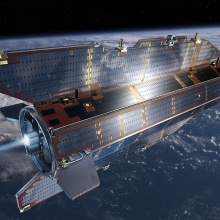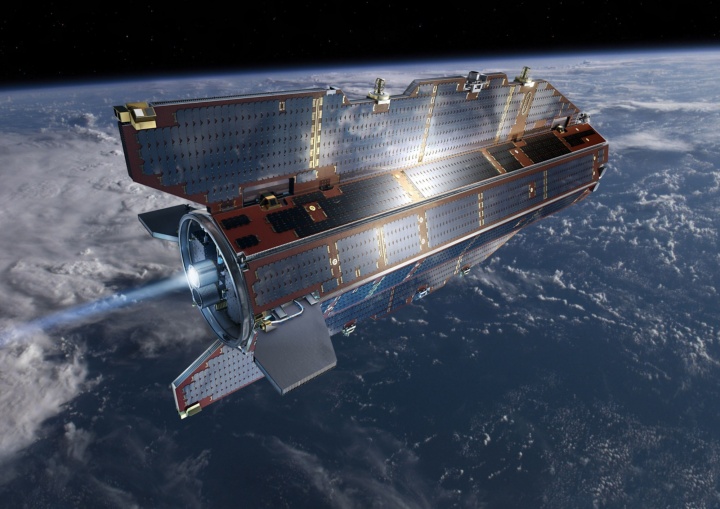Just as air resistance, known as drag, affects vehicles on Earth, the residual atmosphere slows down satellites in space. A research team at the University of Stuttgart’s Institute of Space Systems wants to solve this problem by turning the atmosphere, which causes drag, into propellant. This is an important step toward creating smaller, cheaper satellites that can orbit more closely around the Earth and take higher-quality pictures.
Almost everyone has tried it: On a sunny day, you open the car window and stick your hand outside to feel the air resistance. It makes you feel like you can fly. The force that creates this nice sensation on your hand, however, is an obstacle for the car. A similar problem exists in space: In Earth’s orbit, the residual atmosphere creates drag on flying objects such as satellites.
This causes the satellites to become slower and slower as gravity pulls them toward the Earth until they finally burn up in the atmosphere. This problem is especially serious in Very Low Earth Orbit (VLEO)—about 120 to 250 km above the Earth’s surface—because the denser atmosphere this close to the Earth generates much higher drag than what would be experienced at higher altitudes further in space.
Longer Lifespan, Less Space Debris
Developing satellites for exactly these low altitudes is the goal of the EU project DISCOVERER (DISruptive teChnOlogies for VERy low Earth oRbit platforms), which is led by the University of Manchester and for which the University of Stuttgart has the task of developing an advanced propulsion system. In addition to sending higher-quality pictures back to Earth, these low altitude satellites are smaller and cheaper. A requirement for success, of course, is that the satellite is able to cope with the atmospheric drag.
As part of “DISCOVERER”, Dr. Georg Herdrich and his team at the University of Stuttgart’s Institute of Space Systems are turning the problem into the solution. The scientists’ plan: They want to turn the atmosphere, which produces the drag, into propellant. To this end, the team is working on a propulsion system that is fundamentally different from current technology. Instead of using propellant stored on the satellite, the propulsion system will use atmosphere-breathing electric propulsion. Not only does this contribute to a longer lifespan for the satellite, but it also reduces the danger that comes from space debris.
About DISCOVERER
The DISCOVERER project started at the beginning of 2017 and is funded by the European Union through the Horizon 2020 programme with 5.7 Million Euro over a period of 51 months. In addition to the University of Manchester and the University of Stuttgart, partners include the satellite control centre Deimos Castilla La Mancha (Spain), the Danish company GomSpace, the Universitat Politecnica de Catalunya (Spain), the University College London, the company TechToybox (USA), the consulting company EuroConsult (France) and concentris research management (Germany). DISCOVERER is one of six new Horizon 2020 projects funded by the EU through Future and Emerging Technologies (FET). A total of 594 applicants responded to the FET’s call for proposals.
Media Contact:
Julia Dancer, University of Stuttgart, Institute of Space Systems, Tel.: +49 (0)711 685 62326, E-Mail
Andrea Mayer-Grenu, University of Stuttgart, University Communications, Tel.: +49 (0)711/685 82176,E-Mail
Expert Contact:
Priv.-Doz. Dr. Georg Herdrich, University of Stuttgart, Institute of Space Systems, Tel.: +49 (0)711 685 62412,
E-Mail: herdrich@irs.uni-stuttgart.de



